Purplemath
One definition of "to translate" is "to change from one place, state, form, or appearance to another". When we take a function and tweak its rule so that its graph is moved to another spot on the axis system, yet remains recognizably the same graph, we are said to be "translating" the function.
Usually, translation involves only moving the graph around. Squeezing or stretching a graph is more of a "transformation" of the graph. But these two topics are usually taught at the same time, and usually under the same name. Just be aware that the topic of "function translation" often includes function transformation, and vice versa.
To get started, let's consider one of the simpler types of functions that you've graphed; namely, quadratic functions and their associated parabolas.
When you first started graphing quadratics, you started with the basic quadratic:
f (x) = x2:
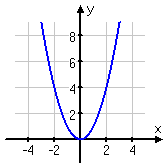
Then you did some related graphs, such as:
g(x) = –x2 – 4x + 5:
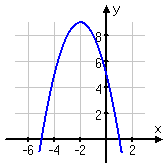
h(x) = x2 – 3x – 4:
k(x) = (x + 4)2:
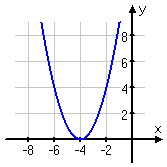
In each of these cases, the basic parabolic shape was the same. The only difference was where the vertex was, and whether it was right-side up or upside-down.
If you've been doing your graphing by hand, you've probably started noticing some relationships between the equations and the graphs. The topic of function transformation makes these relationships more explicit.
Moving up and down
Let's start with the function notation for the basic quadratic:
f (x) = x2
A function transformation takes whatever is the basic function f (x) and then "transforms" it (or "translates" it), which is a fancy way of saying that you change the formula a bit and thereby move the graph around.
For instance, the graph for y = x2 + 3 looks like this:
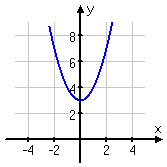
This is three units higher than the basic quadratic, f (x) = x2. That is, x2 + 3 is f (x) + 3. We added a "3" outside the basic squaring function f (x) = x2 and thereby went from the basic quadratic x2 to the transformed function x2 + 3.
This is always true: To move a function up, you add outside the function: f (x) + b is f (x) moved up b units. Moving the function down works the same way; f (x) – b is f (x) moved down b units.
Given g(x) = 4x – 3, what function h(x) would represent a downward shift by two units?
Since the original function is being shifted downward by two units, then the new function is the old one, with a "minus two" tacked onto the end:
g(x) – 2 = (4x – 3) – 2
= 4x – 5
Then the new function is:
h(x) = 4x – 5
Moving left and right
On the other hand, y = (x + 3)2 looks like this:
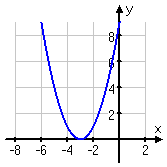
In this graph, f (x) has been moved over three units to the left: f (x + 3) = (x + 3)2 is f (x) shifted three units to the left.
This is always true: To shift a function left, add inside the function's argument: f (x + b) gives f (x)shifted bunits to the left. Shifting to the right works the same way; f (x – b) is f (x) shiftedb units to the right.
Warning: The common temptation is to think that f (x + 3) moves f (x) to the right by three, because "+3" is to the right. But the left-right shifting is backwards from what you might have expected.
Adding moves you to the left; subtracting moves you to the right.
If you lose track, think about the point on the graph where x = 0. For f (x + 3), what does x now need to be for 0 to be plugged into f ? In this case, x needs to be –3, so the argument is –3 + 3 = 0, so I need to shift left by three.
This process will tell you where the x-values, and thus the graph, have shifted. At least, that's how I was able to keep track of things. Yes, I had trouble with this concept, too.
Given f (x) = –x2 + 5x + 2, find the expression, in terms of f , for a leftward shift of five units.
To shift the graph side to side, I need to add or subtract inside the argument of the function (that is, inside the parentheses). To move to the left, I need (counter-intuitively) to add inside the parentheses. To move five units, I'll need to add 5 inside the parentheses.
Then my answer is:
f (x + 5)
Given s(t) = 2t + 4, find the expression for the function w(t) which represents a rightward shift of one unit.
They've told me to shift to the right. To do this, I must (counter-intuitively) subtract inside the argument. They've told me to shift rightward by one unit, so I'll be subtracting by 1.
But they haven't told me to express the new function in terms of the old. They want the actual expression for the rightward shift. So I'll need to do some algebra, plugging in a "t – 1" for every instance of "t " in the original function. Fortunately, that function is really simple, so:
w(t) = s(t – 1)
= 2(t – 1) + 4
= 2t – 2 + 4
= 2t + 2
Then my new function is:
w(t) = 2t + 2
No comments:
Post a Comment